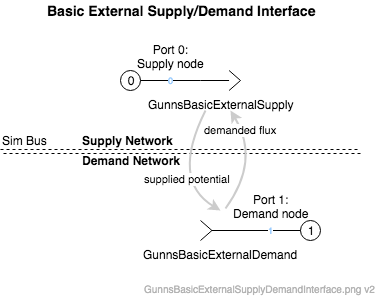GunnsBasicExternalSupply - nasa/gunns GitHub Wiki

This class inherits GunnsBasicSource, and is used in tandem with the GunnsBasicExternalDemand class to flow between two separate electrical or thermal networks, with this class supplying potential (voltage or temperature) to and receiving demanded flux (current or heat flux) from the external demand-side network and applying the flux demand to the local node.
Note: for interfaces between electrical networks, we recommend using the GunnsElectConverterInput and GunnsElectConverterOutput links instead, as their interface will be more stable.
This picture shows how to hook up the GunnsBasicExternalSupply in the local network and the GunnsBasicExternalDemand link in the external network and the simbus interfaces between the networks. The arrowheads in the supply & demand link shapes imply a flow direction from the supply node to the demand node, but in fact flow can go in either direction, and always flows from the higher-potential side to the lower-potential side, as a regular conductor would. The arrowheads simply indicate the direction of positive flow values.

Port Connection Rules (These are limitations on the port connection to nodes that the link enforces in run-time):
- Port 0 cannot be attached to Ground.
- Port 1 must always be attached to Ground. This port is optional. If not drawn, GunnsDraw will automatically connect it to the Ground node.
Other Rules (These are extra rules you should always try to follow):
- The supply link should be used in the network with the higher local capacitance - which is usually the network that has the larger nearby capacitance or potential source.
- In general, the interface location should be chosen where the supply network has a large nearby capacitance relative to the demanded flow rates. In other words, a location where typical interface flow rates will result in small potential changes in the supply network. Such an interface is called "loosely coupled" because the demand network can't really affect the supply network. Loosely coupled interfaces are more stable. "Tightly coupled" interfaces, where even small demand flow rates cause large changes in the supply potential, are very unstable and should be avoided whenever possible.
Configuration Data Parameters:
- N/A
Input Data Parameters:
- malfBlockageFlag (default = false): Initial state of the blockage malfunction activation flag. NOTE: this malfunction should not be used on the supply side in a supply/demand link pair. To block the interface, use the blockage malfunction in the demand link instead.
- malfBlockageValue (default = 0.0, must be (0-1)): Initial state of the blockage malfunction activation value.
- sourceFlux (default = 0.0): This should be left zero.
- Stability issues with the demand link interface are discussed in the GunnsBasicExternalDemand help page.
- N/A